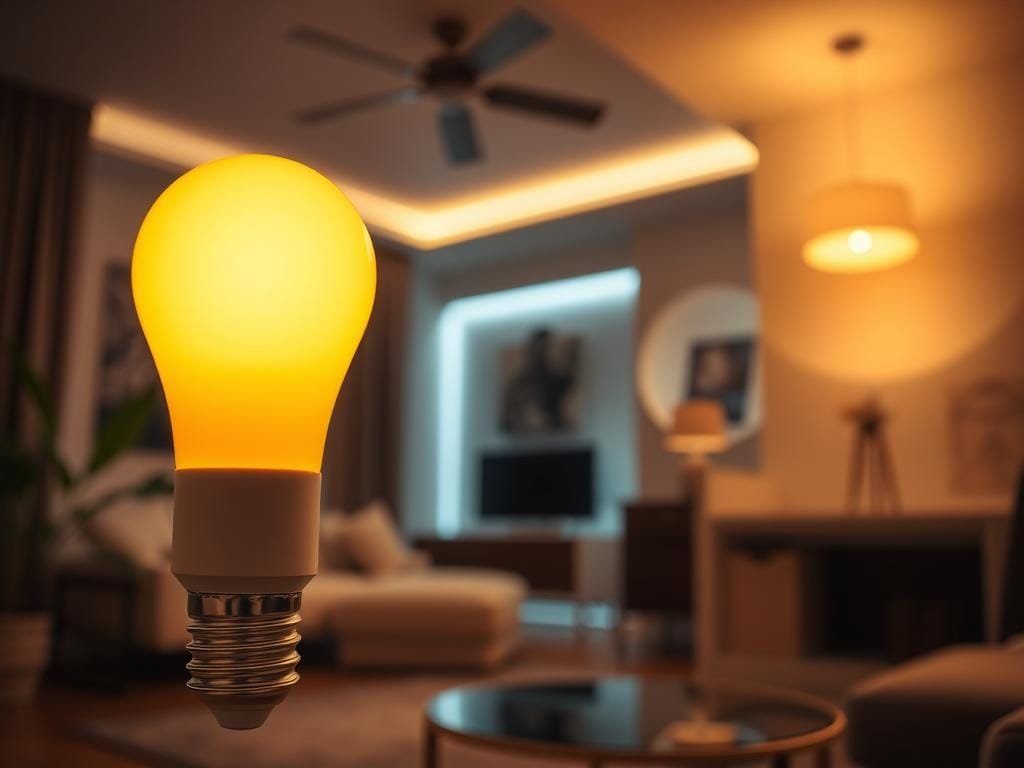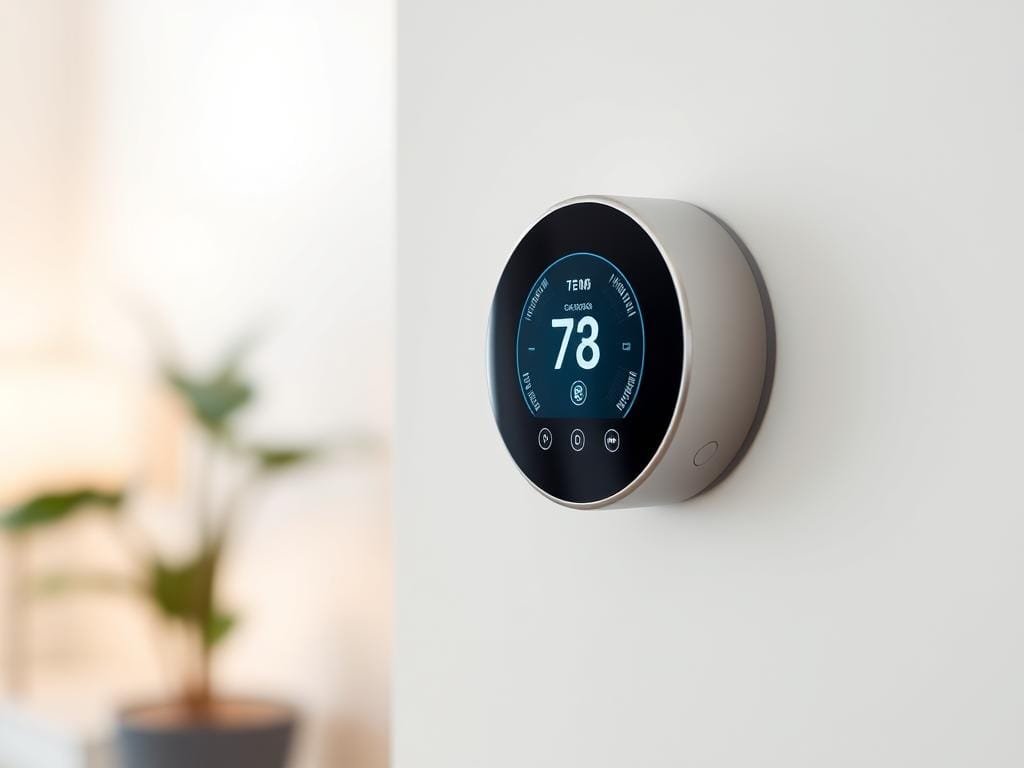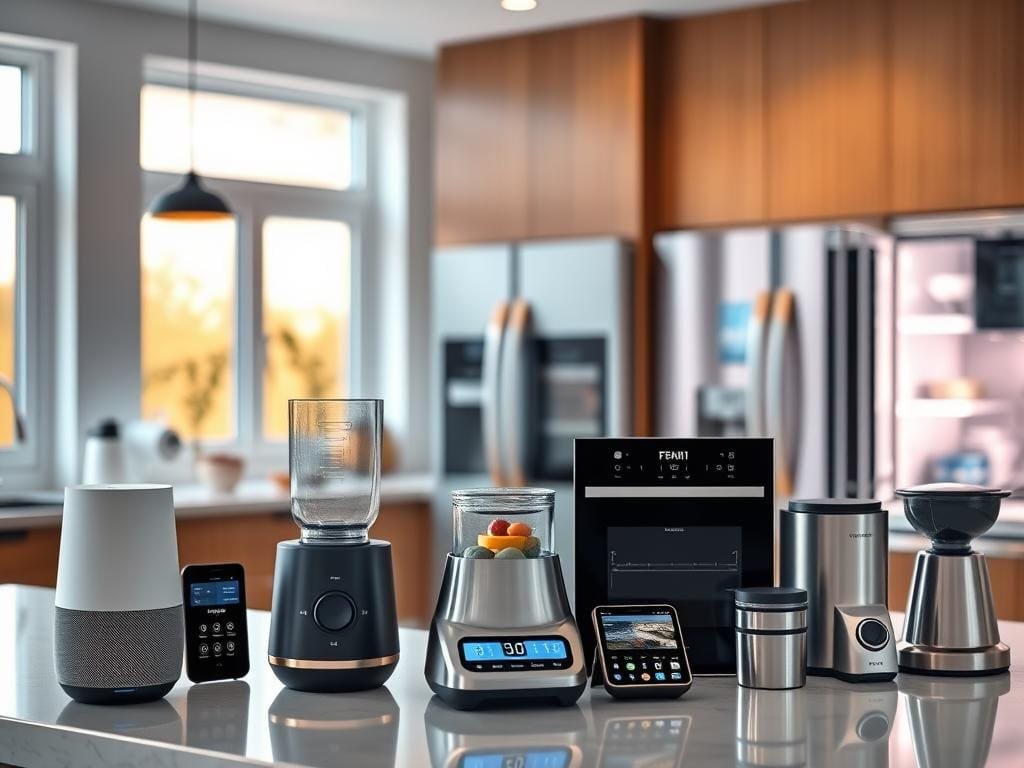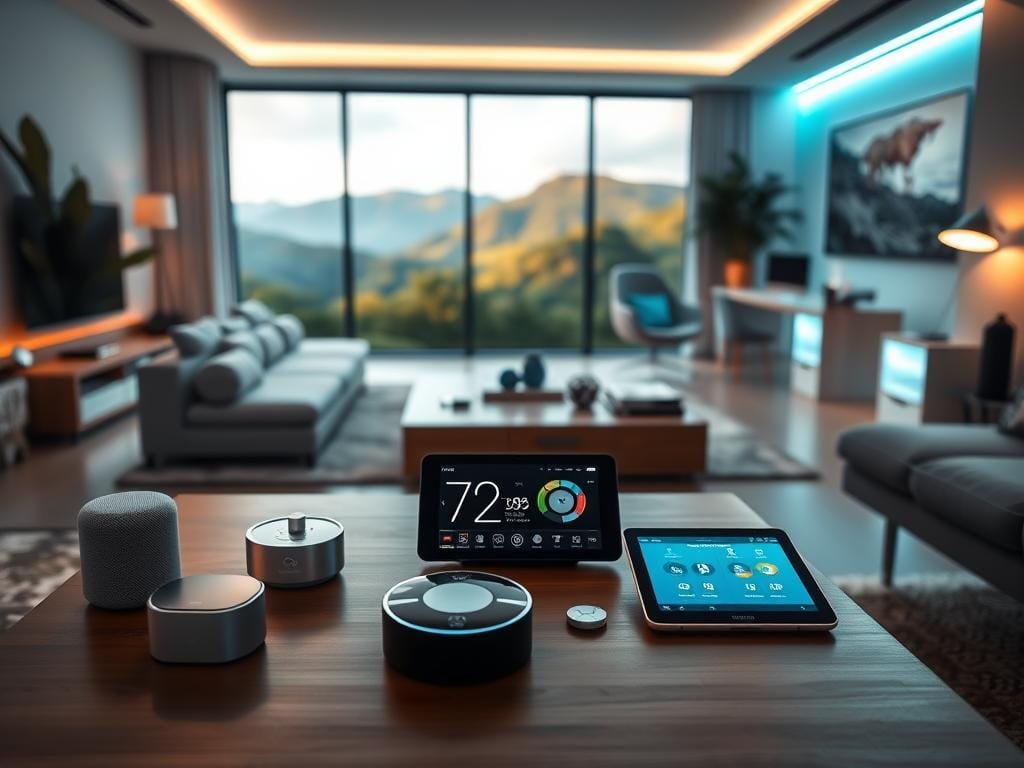Did you know that 63% of participants in a recent survey stated that their main reason for purchasing a smart device was to monitor their property remotely? This shows how popular home automation is becoming. It’s now easier than ever to make your home smart, even if you’re on a tight budget.
With a good plan and the right IoT devices, you can turn your home into a modern, automated space. Start with essentials like lighting, thermostats, and security. This ensures all your devices work well together.
For a detailed guide on starting, check out Building Smart Home: A Step-by-Step Guide. Or, find affordable gadgets and tips on Building a Smart Home on a budget.
Key Takeaways
- Begin with smart security systems for enhanced safety.
- Focus on key areas like lighting and thermostats for automation.
- Ensure device compatibility for seamless integration.
- Implement strong password protection and two-factor authentication.
- Regularly update devices to fix security flaws.
What Makes a Smart Home System Work
A smart home system uses controllers, devices, and interfaces that talk to each other. This setup lets you control and watch your home easily.
Core Components of Home Automation
The key parts of a smart home are essential for it to work. These parts are:
Controllers and Hubs
Controllers and hubs are the smart home’s brain. They connect devices and let them talk to each other. A smart home hub makes controlling many devices easier.
Connected Devices
Devices like smart thermostats, lights, and cameras are the visible parts of a smart home. They make your home more convenient and efficient.
User Interfaces
User interfaces, like apps and voice assistants, let you interact with your smart home. They help you control and check on your devices.
Common Communication Protocols
Devices in a smart home use different ways to talk to each other. These include:
Wi-Fi, Zigbee, and Z-Wave
Wi-Fi is good for its speed. Zigbee and Z-Wave are better for saving power and networking.
Bluetooth and Thread
Bluetooth is great for pairing devices. Thread is becoming popular for its power-saving and networking.
The table below shows what makes each protocol special:
| Protocol | Frequency | Power Consumption | Mesh Networking |
|---|---|---|---|
| Wi-Fi | 2.4/5 GHz | High | No |
| Zigbee | 2.4 GHz | Low | Yes |
| Z-Wave | 908/916 MHz | Low | Yes |
| Bluetooth | 2.4 GHz | Medium | No |
| Thread | 2.4 GHz | Low | Yes |
Benefits of Automated Living
Living with automation brings many benefits. It makes life easier, saves energy, and boosts security. By using smart devices, you can make your home more comfortable and green.
Planning Your Budget-Friendly Smart Home
To make a smart home without spending too much, start with a good plan. You need to figure out what you need, set a budget, and plan how to add things step by step.
Assessing Your Needs and Priorities
First, think about what you really need versus what you just want in your smart home. This is key for home energy management and making sure you’re happy with your intelligent home solutions.
Must-Have vs. Nice-to-Have Features
Figure out what you absolutely need, like security cameras or smart lights. Then, think about what you’d like but don’t really need, like voice-controlled coffee makers.
Identifying High-Impact Areas
Focus on areas that will really change your daily life. For example, smart lighting and temperature control are big ones.
Setting a Realistic Budget
A good budget is the foundation of your smart home project. Make sure to plan your spending based on what’s most important to you.
Cost Breakdown by Category
Split your budget into sections like lighting, security, and entertainment. This helps you spend evenly.
Where to Splurge vs. Save
Decide where it’s okay to spend a bit more on quality products. And where you can save money without losing out on usefulness.
Creating a Phased Implementation Plan
Using a phased plan helps you manage costs and adjust as needed. Start with the basics and add more over time.
First Month, First Year Roadmap
Make a plan for the first month and the first year. Think about what you need right away and what you can look forward to in the future.
Choosing the Right Smart Home Hub
Finding the perfect smart home hub is key to a smooth and efficient system. It connects all your IoT devices and lets them talk to each other.
Comparing Popular Hub Systems
There are many smart home hubs out there, each with its own set of features. The top ones include:
- Amazon Alexa Ecosystem: Famous for its wide range of compatible devices and voice control.
- Google Home Platform: Integrates well with Google services and other smart gadgets.
- Apple HomeKit Environment: Offers a safe and easy experience for Apple users.
| Hub System | Ecosystem | Compatibility |
|---|---|---|
| Amazon Alexa | Wide device support | Over 10,000 devices |
| Google Home | Google services integration | 5,000+ devices |
| Apple HomeKit | Secure Apple ecosystem | 500+ devices |
Budget-Friendly Hub Alternatives
If you’re watching your wallet, consider Raspberry Pi Solutions. They’re affordable and can turn your home into a smart one. You can also reuse old gadgets to save cash. For more on blending tech into your life, check out The Rise of Ambient Computing.
Hub-Free Smart Home Options
Some devices don’t need a central hub. They use direct peer-to-peer connections or cloud services. This makes setting up your smart home easier and can boost your smart security system.
Affordable Smart Lighting Implementation
Turning your home into a smart one doesn’t have to cost a lot. You can find many options to make your home smart without spending too much. You can use smart bulbs or smart switches, each with its own benefits.
Smart Bulbs vs. Smart Switches: Cost Analysis
Choosing between smart bulbs and smart switches depends on your budget. Smart bulbs are cheaper to buy, but smart switches might save you money in the long run.
Entry-Level Options Under $20
If you’re on a tight budget, there are smart bulbs under $20. Brands like Wyze offer affordable smart lighting that’s easy to add to your home.
Mid-Range Solutions Under $50
For a bit more money, you can get mid-range smart lighting under $50. These offer more features and better quality. TP-Link and Sengled are great brands in this range.
Budget-Friendly Lighting Brands
Many brands offer smart lighting that’s easy on your wallet. Wyze, TP-Link, and Sengled are known for their affordable and quality products.
Wyze, TP-Link, and Sengled Options
- Wyze: Known for their extremely affordable smart bulbs and plugs.
- TP-Link: Offers a range of smart lighting products with advanced features.
- Sengled: Provides a variety of smart lighting solutions, including bulbs and strips.
DIY Smart Lighting Projects
If you like DIY projects, smart lighting can be a fun and affordable project. Using ESP8266-based solutions is a popular choice.
ESP8266-Based Solutions
ESP8266 modules are cheap and versatile. They let you create your own smart lighting projects. You can find many tutorials online to help you start. For more on setting up a smart home on a budget, check out this guide.
| Brand | Product | Price Range |
|---|---|---|
| Wyze | Smart Bulb | $10-$20 |
| TP-Link | Smart Bulb | $20-$40 |
| Sengled | Smart Bulb | $15-$30 |

Smart Home Security Without Breaking the Bank
Keeping your home safe doesn’t have to cost a lot. There are many ways to make your home more secure without spending a lot. With some planning and creativity, you can set up a strong smart security system that works well with your home automation.
Affordable Security Cameras and Doorbells
Cameras and doorbells are key for smart home security. Brands like Wyze and Eufy offer budget-friendly options that are high quality. For example, Wyze’s outdoor camera is weather-resistant and has night vision, all at a good price.
When comparing Wyze, Eufy, and Ring, you can find the best option for your needs. Wyze is simple and cheap, Eufy has advanced features like AI detection, and Ring has a big ecosystem. For more tips on home security, check out this resource.
Free vs. Paid Monitoring Services
Choosing between free and paid monitoring services is important. Free services can save money, but paid services offer more like professional monitoring and cloud storage. For example, Ring’s paid service has 24/7 monitoring, which is a good investment for better security.
DIY Security Sensors and Systems
DIY security sensors are a cheap way to improve your home’s security. You can easily install door and window sensors and connect them to your smart home system.
Door/Window Sensors Under $15
Door and window sensors cost less than $15, making them a cheap addition to your security. These sensors can alert you to any unauthorized entry, making your home safer.
Motion Detection Solutions
Motion detection is key for home security. Affordable motion detectors can be placed around your home to detect unusual activity. They send alerts to your phone or other devices.
Repurposing Old Smartphones as Security Devices
Using old smartphones as security cameras is a smart and cheap idea. Apps like Alfred can turn your old phone into a security camera with motion detection and alerts.
By using these affordable security measures, you can build a complete smart security system that keeps your home safe without breaking the bank.
Energy-Saving Climate Control Systems
Improving your home’s climate control can cut down on energy use. Smart home tech lets you create an intelligent home solution. It adjusts to your needs and lowers your energy bills.
Budget Smart Thermostats
Starting with budget-friendly smart thermostats is a smart move. Devices like the Amazon Smart Thermostat and Wyze Thermostat are affordable yet feature-rich.
Amazon Smart Thermostat vs. Wyze Thermostat
When picking between the Amazon Smart Thermostat and Wyze Thermostat, think about compatibility, features, and cost. The Amazon Smart Thermostat works well with Alexa, while the Wyze Thermostat is cheaper but just as capable.
| Features | Amazon Smart Thermostat | Wyze Thermostat |
|---|---|---|
| Compatibility | Alexa-enabled devices | Google Assistant, Alexa |
| Price | $149 | $69 |
Installation Without Professional Help
Many smart thermostats are easy to install yourself. Just follow the instructions for a hassle-free setup. This can save you money and make you feel accomplished.
Smart Plugs for Heating and Cooling
Smart plugs let you control heating and cooling devices from afar. They’re great for space heaters and fans.
Controlling Space Heaters and Fans
Smart plugs help you schedule your space heaters and fans. This way, they only run when needed, saving energy. It’s a simple yet effective way to make your home more energy-efficient.

Energy-Saving Automation Routines
Automation routines can optimize your home’s energy use. By setting routines that adjust your climate control, you can save even more energy.
Presence-Based Temperature Control
Presence-based temperature control lets your thermostat adjust based on whether you’re home or away. It’s a great way to save energy when you’re not around.
“Smart home technology has changed how we manage energy. By using smart thermostats and automation, homeowners can cut their energy bills a lot.”
Entertainment and Media on a Budget
Getting smart home entertainment on a budget is easier than you might think. You can enjoy top-notch entertainment without spending too much.
Affordable Smart Speakers
Smart speakers are key to any smart home entertainment system. You don’t have to break the bank to start. The Echo Dot and Nest Mini offer great sound and smart features at a low cost.
Echo Dot and Nest Mini Comparison
When picking between the Echo Dot and Nest Mini, think about your ecosystem. The Echo Dot is great with Alexa devices. The Nest Mini is best for Google Assistant users.
| Feature | Echo Dot | Nest Mini |
|---|---|---|
| Voice Assistant | Alexa | Google Assistant |
| Sound Quality | Good | Good |
| Price | $40-$50 | $30-$40 |
Budget-Friendly Streaming Devices
Streaming devices are vital for watching your favorite shows. The Fire TV Stick and Roku Express are cheap but offer lots of streaming services.
Fire TV Stick vs. Roku Express
The Fire TV Stick is great for Amazon Prime members, giving easy access to Prime Video. Roku Express, on the other hand, supports more streaming services, making it a good choice for a wide range of content.
“The best streaming device is one that integrates well with your existing ecosystem and provides access to the content you want.” – Tech Reviewer
Creating Multi-Room Audio Without Premium Brands
You can set up multi-room audio without spending a lot. Look for affordable devices that support group playback, like Wi-Fi 7 enabled devices for easy connection.
Group Playback Solutions
Many cheap smart speakers and streaming devices have group playback. This lets you play music in sync across rooms, making for a better audio experience.
Making Your Kitchen Smarter for Less
Turning your kitchen into a smart space doesn’t have to cost a lot. You can find affordable gadgets and use what you already have. This way, your kitchen will be both useful and modern.
Low-Cost Smart Kitchen Gadgets
Getting smart kitchen gadgets on a budget can really improve your cooking. Look for devices that are both useful and cheap.
Smart Coffee Makers Under $50
The Smarter Coffee Machine lets you make coffee from your phone. It’s under $50, making it a great start for smart kitchen tech.
Budget-Friendly Cooking Assistants
The Anova’s Precision Cooker helps with sous vide cooking by controlling temperature. It’s not the cheapest, but it’s worth it for its features.
Converting Regular Appliances with Smart Plugs
Smart plugs are a smart way to make your kitchen smarter. They turn any appliance into a smart one, letting you schedule and monitor power.
Scheduling and Power Monitoring
Smart plugs let you set when appliances turn on or off. This saves energy. For example, your coffee maker can start brewing when you wake up. For more ideas, check out best smart home devices for your kitchen.
Voice-Controlled Kitchen Setups
Adding voice control to your kitchen makes cooking easier. Devices like Amazon Echo or Google Home control gadgets, set timers, and find recipes for you.

With these affordable gadgets and tech, you can make cooking better without spending too much.
Creating Powerful Automation Routines
Creating powerful automation routines is key to unlocking your smart home’s full power. By automating daily tasks, you can simplify your life and make your home more efficient.
Daily Life Automations
Daily life automations can change your daily routine a lot. For example, you can set up routines to wake you up in the morning or help you relax in the evening.
Morning Wake-Up Sequences
Imagine starting your day with your blinds opening, your coffee maker brewing, and your favorite podcast playing. You can make this happen with automation routines.
- Set your blinds to open at a specific time
- Turn on your coffee maker
- Play your favorite podcast
Evening Wind-Down Routines
In the evening, you can automate your home to relax. This could include dimming lights, locking doors, and adjusting the thermostat.
- Dim your lights to a warm setting
- Lock all doors
- Adjust the thermostat for a comfortable sleep temperature
Vacation and Away Modes
When you’re away from home, you can use automation to make it look like someone is there.
Simulating Occupancy
This can be done by automating your lights to turn on and off at random times. It makes your home look occupied.
Trigger-Based Smart Home Scenes
Trigger-based scenes let you automate actions based on specific triggers like location, time, or sensor data.
Location, Time, and Sensor Triggers
For example, you can set your home to turn on the AC when you arrive or adjust the lighting based on the time of day.
Key benefits include:
- Increased convenience
- Enhanced energy efficiency
- Improved home security
Troubleshooting Your DIY Smart Home
Running into problems with your smart home devices is normal. But knowing how to fix them can save a lot of time and stress. As you keep adding to your smart home, being able to find and fix issues quickly is very important.
Solving Connectivity Problems
Most smart home issues are about connecting devices. The first thing to do is make sure they’re linked to a strong network.
Wi-Fi Optimization Techniques
To improve your Wi-Fi, try a few things:
- Update your router’s software
- Switch the Wi-Fi channel to avoid interference
- Use Quality of Service (QoS) settings to help smart devices
Mesh Network Considerations
A mesh network can help cover your home better and fix connectivity problems. Here’s how:
- Place nodes in key spots around your home
- Make sure nodes are updated and set up right
Addressing Device Compatibility Issues
Getting devices to work together can be tricky. It’s important to make sure they all play nice for a smooth smart home experience.
Using IFTTT and Other Integration Tools
Tools like IFTTT can help devices that don’t normally work together. You can make special recipes to let different devices talk to each other.
Updating and Maintaining Your System
Keeping your smart home up to date and well-maintained is key. It helps your system last longer and work better.
Creating a Maintenance Schedule
Make a plan to check for updates on your devices and hub regularly. This keeps your system safe and running smoothly.
| Maintenance Task | Frequency | Notes |
|---|---|---|
| Check for device updates | Monthly | Ensure all devices are running the latest firmware |
| Review IFTTT recipes | Quarterly | Update or delete recipes as needed |
| Inspect network performance | Bi-annually | Check for interference and optimize as necessary |

Conclusion: Enjoying Your Budget-Friendly Smart Home
Creating a Smart Home on a budget is possible with good planning and the right devices. This guide has helped you start on the path to a more convenient, secure, and energy-efficient home. A well-designed home automation system can really improve your living experience.
As you’ve learned, you can build a connected home without spending a lot. There are many affordable options, from smart lighting to security systems. For example, upgrading your home Wi-Fi network with mesh systems, as discussed in upgrading your home Wi-Fi network, can make your smart home work better.
With a budget-friendly Smart Home, you can save energy and feel safer, as shown in the pros of having a smart home. Now, it’s time to begin your smart home journey and see how it can change your daily life.
FAQ
What is a smart home, and how does it work?
A smart home uses advanced tech to connect and control systems like lights, temperature, and security. It connects devices through a central hub. This lets you manage your home from a smartphone or voice assistant.
What are the benefits of having a smart home?
Smart homes offer convenience, save energy, and boost security. They also increase your home’s value. Plus, you can control your home from anywhere.
What is the role of a smart home hub in a home automation system?
A smart home hub connects and controls devices in your home. It lets you manage everything with one interface. This makes running your smart home easier.
What are some common communication protocols used in smart home devices?
Smart devices often use Wi-Fi, Bluetooth, Zigbee, and Z-Wave. These protocols help devices talk to each other and the hub. This ensures smooth control and integration.
How can I make my smart home more energy-efficient?
To save energy, use smart thermostats and lighting. Smart plugs can also help. Set up routines to match your habits and save energy.
What are some budget-friendly options for smart home security?
For affordable security, try cheap cameras and DIY sensors. Old smartphones can also be repurposed. Free or paid monitoring services can add extra security.
Can I create a smart home on a budget?
Yes, you can build a smart home affordably. Prioritize needs, set a budget, and choose cheap devices. DIY projects and repurposing old devices can also save money.
How do I troubleshoot common issues in my DIY smart home?
To fix DIY smart home problems, check connections and compatibility. Update your system regularly. User manuals and online resources can also help.
What are some affordable smart home devices that I can start with?
Begin with smart bulbs, plugs, and speakers. They’re cheap and can kickstart your smart home journey.
Can I integrate different smart home devices and systems?
Yes, you can mix different devices with a smart home hub. Many devices work with various protocols. This makes integration easier.
